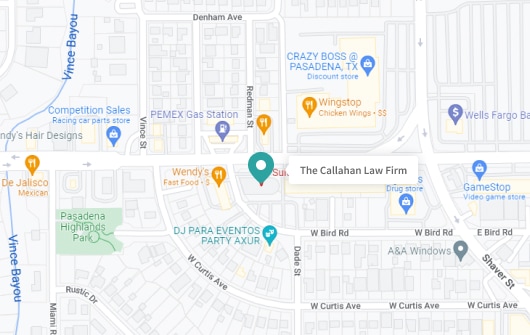Texas is an “At-Fault” State. What Does That Mean for Your Car Accident Claim?

Texas has an “at-fault” insurance system that comes into play when you have a car accident. But what does that mean for your car accident claim? Well, in simple terms, it means that when an accident happens, someone is usually considered responsible or “at-fault” for causing it.
This person’s insurance company is responsible for paying for damages and injuries caused by the accident. In states which use a “no-fault” system, you generally make a claim against your own insurance company for any injuries or damages you suffer in a car wreck regardless of who caused the collision.
Whether your insurance policy is governed by an “at-fault” or “no-fault” system can directly and significantly affect how a claim is handled. It will also affect the compensation that a person may receive after being injured in an automobile accident.
In this article, we will explore what being in an “at-fault” State like Texas means for you if you find yourself in a car accident. We’ll break down the key elements of a car accident claim, explain how fault is determined, and explain what steps you should take to protect your rights after an accident occurs.
What are Fault-Based Car Accident Claims in Texas?

Because Texas follows an “at-fault” system, the party responsible for causing the accident is called the “at-fault” driver, and their insurance company is responsible for covering the damages and injuries resulting from the accident.
But what does “fault” mean? In car accident claims, “fault” is the degree of responsibility each driver holds for causing the accident. Understanding the concept of fault is crucial because it directly impacts who will be responsible for compensating the accident victims. The other driver’s insurance company should cover your damages if you were not at fault, but, on the other hand, if you were at fault, your insurance will likely handle the expenses.
What is The Difference Between ‘At-Fault’ and ‘No-Fault’?
The main difference between “at-fault” and “no-fault” systems is how responsibility for an accident or injury is determined and how insurance claims are handled.
What It Means to Be an “At-Fault” State
Most states, including Texas, use an “at-fault” automobile insurance system. This type of system is based on tort liability, which means the driver who caused the accident is responsible for the damages and injuries resulting from the accident.
In an “at-fault” state, The responsible (or “at-fault”) driver’s insurance company pays for the damages sustained according to the insured’s degree of fault. And if the injured person believes the offer is inadequate, that person may file a lawsuit for damages – medical expenses, pain, mental anguish, impairment, disfigurement, loss of earnings – and allow a judge or jury to determine fault and the amount of damages.
What It Means to Be a “No-Fault” State
In this type of system, each insurance company compensates its policyholder for injuries regardless of who is at fault. This type of insurance system can provide a limited right to sue, and states with a no-fault system will typically establish thresholds for the minimum damages necessary to file a lawsuit.
Many variations of no-fault systems differ by state, including Florida, Kansas, Kentucky, Michigan, New Jersey, New York, and Utah. A variation is what is known as a “choice” state, which allows drivers to choose either an “at-fault” or a “no-fault” insurance policy. If the driver has an at-fault insurance policy, the claims procedure typically works like a traditional at-fault system.
Texas’ Fault System by the Numbers
As an “at-fault” state, Texas requires drivers to have a minimum level of auto insurance. As of 2023, the minimum amount required in Texas is $30,000 in bodily injury coverage per person, $60,000 in bodily injury coverage per accident, and $25,000 for property damage. The “at-fault” driver’s insurance policy must pay the other individual’s bodily injury claim and property damage if it is determined the driver is at fault for the accident.
What About Accidents With Shared Fault?

It is still possible to file a claim and receive compensation if more than one driver is at-fault for the accident. Texas is a comparative fault state, meaning a claimant can recover damages if their level of fault for the collision is 50% or less. If a claim cannot be settled, a judge or jury will determine the percentage of each driver’s fault. And that percentage will affect how much and whether a person makes a financial recovery.
Let’s take a look at an example to clarify the shared fault. Consider a situation where the judge or jury determines a claimant is 15% at fault for an auto accident, the defendant is 85% at fault, and the total amount awarded to the claimant is $100,000. Considering the proportionate responsibility, the claimant’s net award is $85,000. If, however, the claimant was determined to be 51% or more at fault, then the claimant’s award would be $0.
What Role Does Insurance Play in At-Fault States?
Car insurance plays a crucial role in providing coverage and financial protection in the event of an accident. Here’s what you need to know about car insurance in Texas:
Minimum Insurance Requirements in Texas
As an at-fault state, Texas requires all drivers to carry a minimum amount of liability insurance. This insurance coverage is designed to pay for the damages and injuries sustained by others if you are at fault in an accident. The minimum liability insurance requirements in Texas are:
- $30,000 bodily injury liability coverage per person
- $60,000 bodily injury liability coverage per accident (if multiple people are injured)
- $25,000 property damage liability coverage per accident
These are the minimum amounts of insurance that drivers must carry to comply with the law. However, many people opt for higher coverage limits to protect themselves in case of a serious accident with significant damages.
What are the Types of Car Insurance Coverage in Texas?

In addition to liability insurance, drivers in Texas can choose from various optional insurance coverages to enhance their protection. Some common types of optional car insurance coverage include:
- Collision Coverage: This coverage pays for the repair or replacement of your vehicle in the event of a collision, regardless of who is at fault.
- Comprehensive Coverage: Comprehensive insurance covers damages to your vehicle caused by non-collision events, such as theft, vandalism, fire, or natural disasters.
- Personal Injury Protection (PIP): PIP coverage helps pay for lost wages and medical expenses for you and your passengers, regardless of fault.
- Uninsured/Underinsured Motorist Coverage (UM/UIM): This coverage protects you if you’re involved in an accident with a driver who doesn’t have enough insurance to cover your damages.
Subrogation and Its Impact on Claims
Subrogation is essential to car insurance claims in at-fault states like Texas. When your insurance company pays for your damages, they may have the right to seek reimbursement from the at-fault driver’s insurance company. This process is known as subrogation.
For instance, if the other driver was at fault for the accident and your insurance company covered your medical expenses, in that case, they might try to recover those expenses from the at-fault driver’s insurance company through subrogation.
How can I File a Car Accident Claim in Texas?
If you are in a car accident in Texas, understanding the process of filing a claim is crucial. Since Texas is an at-fault state, you must navigate the claims process carefully to seek compensation for your damages and injuries. Here’s a step-by-step guide on what to do after a car accident:
- Take immediate action after the accident.
- Check for injuries and call emergency services if needed.
- Move your vehicle to a safe location, and turn on hazard lights to alert other drivers.
- Call the police to report the accident, as an official police report can be valuable for your claim.
- Gather evidence to support your claim.
- Notify your insurance company about the accident, providing them with all relevant information and evidence you have collected.
What Are the Benefits of Hiring a Car Accident Attorney?
When you have an experienced car accident attorney on your side, you gain several advantages:
- You gain legal expertise on your case.
- You have a legal representative who can help you negotiate your claim.
- Attorneys have the resources to conduct thorough investigations and gather evidence to support your claim.
- Having an attorney handle communications with insurance companies can protect your rights and prevent you from making statements that may negatively impact your claim.
What to Look for in a Car Accident Lawyer
When seeking legal representation for your car accident claim, consider the following:
- Look for an attorney with a proven track record of handling car accident cases and achieving successful outcomes.
- Check online reviews and testimonials to gauge the attorney’s reputation and client satisfaction.
- Ensure the attorney communicates clearly and promptly, keeping you informed throughout the process.
- Check the payment plan. Many car accident attorneys work on a contingency fee basis, meaning they only get paid if they win your case.
How Attorneys Can Strengthen Your Claim
Having an attorney by your side can significantly strengthen your car accident claim. They can help you do the following:
- They can help you build a strong case by gathering evidence to present a compelling case on your behalf.
- Experienced attorneys can accurately assess the value of your claim, taking into account all your damages, both current and potential future expenses.
- Attorneys are skilled negotiators and can engage in settlement talks with the insurance company to pursue the best possible outcome for you.
Do You Need Help with a Car Accident Claim?
An experienced car accident attorney can help you figure out how Texas auto laws apply to your case and what kind of compensation you may receive. To learn more about your legal options following an accident, contact The Callahan Law Firm today.
Our team of experienced car accident attorneys in Houston and Pasadena, Texas can provide you with the guidance and support you need to receive the compensation you deserve.
FAQs
Is Texas a fault or no-fault state?
Texas is an “at-fault” state. In an “at-fault” state like Texas, the driver determined to be responsible for causing the accident is liable for the damages and injuries resulting from the collision. The at-fault driver’s insurance company is generally responsible for compensating the victims.
Is Texas a 50-50 state for car accidents?
No, Texas is not a “50-50” state for car accidents. Texas follows a “Modified Comparative Fault” system called “Proportionate Responsibility.” Under this system, each driver involved in the accident can be assigned a percentage of fault for the collision. If a driver is found to be 50% or more at fault, they may not be eligible to receive compensation from the other party.
Is it always your fault if you hit someone from behind in Texas?
In Texas, the driver who rear-ends another vehicle is often considered at fault for the accident. This is because the law assumes that the driver who struck the vehicle from behind did not maintain a safe following distance or was not paying proper attention. However, there may be exceptions, such as if the driver in front suddenly stops without a valid reason or fails to use proper signals.
How is fault determined in Texas?
Fault in a car accident in Texas is determined by assessing the actions and behavior of each driver leading up to the collision. Insurance adjusters, police reports, eyewitness testimonies, and other evidence are considered during the investigation. The percentage of fault is then assigned to each driver based on their contribution to the cause of the accident. This determination of fault plays a significant role in deciding who is responsible for compensating the injured parties.

Michael S Callahan is an attorney and founder of The Callahan Law Firm. He focuses his practice on representing individuals and families in personal injury cases involving motor vehicle and truck accidents, workplace accidents and defective products. With over 25 years of experience, he is dedicated to fighting on behalf of people whose lives have been forever altered by the negligence and carelessness of corporations and individuals. Originally trained as a mechanical engineer, Michael has been practicing law and fighting for justice for those who need it most since 1994. He is board-certified in Personal Injury Trial Law by the Texas Board of Legal Specialization and a member of various esteemed legal associations. Outside of work, Michael enjoys spending quality time with his family, outdoor activities, and continually striving to improve as a trial lawyer and human being.











